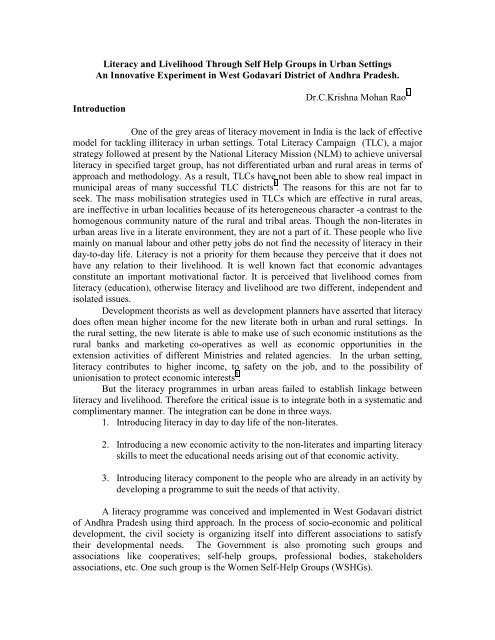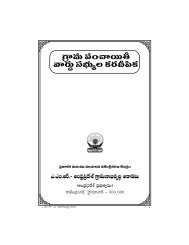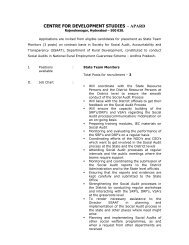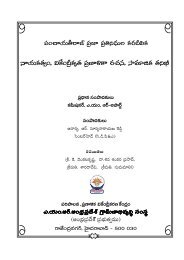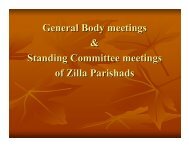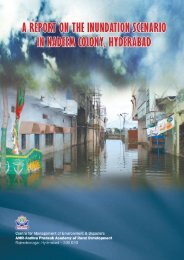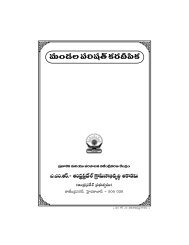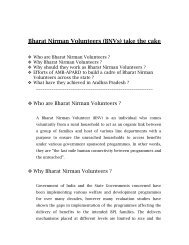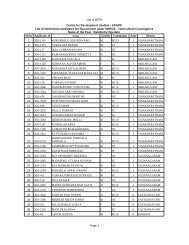Literacy and Livelihood Through Self Help Groups in Urban Settings
Literacy and Livelihood Through Self Help Groups in Urban Settings
Literacy and Livelihood Through Self Help Groups in Urban Settings
Create successful ePaper yourself
Turn your PDF publications into a flip-book with our unique Google optimized e-Paper software.
<strong>Literacy</strong> <strong>and</strong> <strong>Livelihood</strong> <strong>Through</strong> <strong>Self</strong> <strong>Help</strong> <strong>Groups</strong> <strong>in</strong> <strong>Urban</strong> Sett<strong>in</strong>gsAn Innovative Experiment <strong>in</strong> West Godavari District of Andhra Pradesh.IntroductionDr.C.Krishna Mohan Rao 1One of the grey areas of literacy movement <strong>in</strong> India is the lack of effectivemodel for tackl<strong>in</strong>g illiteracy <strong>in</strong> urban sett<strong>in</strong>gs. Total <strong>Literacy</strong> Campaign (TLC), a majorstrategy followed at present by the National <strong>Literacy</strong> Mission (NLM) to achieve universalliteracy <strong>in</strong> specified target group, has not differentiated urban <strong>and</strong> rural areas <strong>in</strong> terms ofapproach <strong>and</strong> methodology. As a result, TLCs have not been able to show real impact <strong>in</strong>municipal areas of many successful TLC districts 2 . The reasons for this are not far toseek. The mass mobilisation strategies used <strong>in</strong> TLCs which are effective <strong>in</strong> rural areas,are <strong>in</strong>effective <strong>in</strong> urban localities because of its heterogeneous character -a contrast to thehomogenous community nature of the rural <strong>and</strong> tribal areas. Though the non-literates <strong>in</strong>urban areas live <strong>in</strong> a literate environment, they are not a part of it. These people who livema<strong>in</strong>ly on manual labour <strong>and</strong> other petty jobs do not f<strong>in</strong>d the necessity of literacy <strong>in</strong> theirday-to-day life. <strong>Literacy</strong> is not a priority for them because they perceive that it does nothave any relation to their livelihood. It is well known fact that economic advantagesconstitute an important motivational factor. It is perceived that livelihood comes fromliteracy (education), otherwise literacy <strong>and</strong> livelihood are two different, <strong>in</strong>dependent <strong>and</strong>isolated issues.Development theorists as well as development planners have asserted that literacydoes often mean higher <strong>in</strong>come for the new literate both <strong>in</strong> urban <strong>and</strong> rural sett<strong>in</strong>gs. Inthe rural sett<strong>in</strong>g, the new literate is able to make use of such economic <strong>in</strong>stitutions as therural banks <strong>and</strong> market<strong>in</strong>g co-operatives as well as economic opportunities <strong>in</strong> theextension activities of different M<strong>in</strong>istries <strong>and</strong> related agencies. In the urban sett<strong>in</strong>g,literacy contributes to higher <strong>in</strong>come, to safety on the job, <strong>and</strong> to the possibility ofunionisation to protect economic <strong>in</strong>terests 3 .But the literacy programmes <strong>in</strong> urban areas failed to establish l<strong>in</strong>kage betweenliteracy <strong>and</strong> livelihood. Therefore the critical issue is to <strong>in</strong>tegrate both <strong>in</strong> a systematic <strong>and</strong>complimentary manner. The <strong>in</strong>tegration can be done <strong>in</strong> three ways.1. Introduc<strong>in</strong>g literacy <strong>in</strong> day to day life of the non-literates.2. Introduc<strong>in</strong>g a new economic activity to the non-literates <strong>and</strong> impart<strong>in</strong>g literacyskills to meet the educational needs aris<strong>in</strong>g out of that economic activity.3. Introduc<strong>in</strong>g literacy component to the people who are already <strong>in</strong> an activity bydevelop<strong>in</strong>g a programme to suit the needs of that activity.A literacy programme was conceived <strong>and</strong> implemented <strong>in</strong> West Godavari districtof Andhra Pradesh us<strong>in</strong>g third approach. In the process of socio-economic <strong>and</strong> politicaldevelopment, the civil society is organiz<strong>in</strong>g itself <strong>in</strong>to different associations to satisfytheir developmental needs. The Government is also promot<strong>in</strong>g such groups <strong>and</strong>associations like cooperatives; self-help groups, professional bodies, stakeholdersassociations, etc. One such group is the Women <strong>Self</strong>-<strong>Help</strong> <strong>Groups</strong> (WSHGs).
volunteers is very limited. Further, most of the volunteers are tra<strong>in</strong>ed <strong>in</strong> synthetic method<strong>in</strong> schools <strong>and</strong> this (IPCL) method is entirely new to them.The primers used <strong>in</strong> the Akshara Mahila programme were prepared based onexperience <strong>in</strong> teach<strong>in</strong>g adults. Theoretically synthetic method is followed <strong>in</strong> the primers<strong>and</strong> used traditional alphabetical sequence of Telugu for easy learn<strong>in</strong>g. As per the report 4published by National <strong>Literacy</strong> Mission, Synthetic method, which is popular as lettermethod proved far superior to the word method <strong>in</strong> every aspect of learn<strong>in</strong>g. Read<strong>in</strong>g <strong>and</strong>writ<strong>in</strong>g are separated tak<strong>in</strong>g <strong>in</strong>to consideration of cognitive skills of adults for fastlearn<strong>in</strong>g. Group teach<strong>in</strong>g methods were adopted for effective teach<strong>in</strong>g <strong>and</strong> make it easy<strong>and</strong> <strong>in</strong>terest<strong>in</strong>g to the adult illiterates. The primers were experimented <strong>in</strong> a pilot centre<strong>and</strong> thoroughly revised to suit the learn<strong>in</strong>g needs of women group.Cost: Generally <strong>in</strong> TLC cost per learner is <strong>in</strong> the range of Rs.70/- to Rs. 90/- <strong>in</strong>clud<strong>in</strong>gthe cost of environment build<strong>in</strong>g. It was thought that the expenditure on awarenesscampaign would not be necessary as the people <strong>in</strong> organised groups realized theimportance of literacy; the cost was reduced to that extent. Thus the expenditure <strong>in</strong> thisprogramme was the lowest when compared to any other literacy activity. Only learn<strong>in</strong>gmaterial i.e. one read<strong>in</strong>g book <strong>and</strong> one work book <strong>and</strong> a pencil was supplied to thelearners <strong>in</strong> addition to the adm<strong>in</strong>istrative <strong>and</strong> technical support by ZSS. All otherexpenditure like teach<strong>in</strong>g aids,tra<strong>in</strong><strong>in</strong>g, etc was me by the group ifself.Differences between TLC <strong>and</strong> Group Based ApproachesSpecification Total <strong>Literacy</strong> Campaign Group Based ApproachUnit District GroupApproach Mass campaign SelectiveMode of reach<strong>in</strong>g people Mass publicity campaign Personal <strong>in</strong>teractionDuration of course Six months (200 hours) Three months (180 hours)Primers Uniform for all the people Group specificMethod of teach<strong>in</strong>g Analytic (word/sentence) Synthetic (alphabetic)Cost per learner Rs.70.00 to Rs.90.00 Rs. 25.00 to Rs.30.00When the two approaches are compared, TLC is effective <strong>in</strong> awareness generation<strong>and</strong> mass mobilization, whereas, AMP’s group based approach is more result oriented <strong>in</strong>terms of actual teach<strong>in</strong>g <strong>and</strong> learn<strong>in</strong>g activity, cost <strong>and</strong> time. The former is useful <strong>in</strong>macro process while the latter is efficient <strong>in</strong> micro process of teach<strong>in</strong>g <strong>and</strong> learn<strong>in</strong>g.Operationalisation of the ProgrammeThe West Godavari Zilla Sakharatha Samithi <strong>and</strong> Municipal authorities jo<strong>in</strong>tlyidentified the SHGs, <strong>in</strong>terested <strong>in</strong> tak<strong>in</strong>g up this programme. Group leaders of selectedSHGs were apprised about the programme at the meet<strong>in</strong>g conducted at municipality
level. Then the group leaders selected the volunteers <strong>and</strong> learners <strong>and</strong> also madearrangements for conduct of literacy classes. The municipal resource persons tra<strong>in</strong>ed thevolunteers for two days on motivational techniques <strong>and</strong> teach<strong>in</strong>g methods. A system ofweekly monitor<strong>in</strong>g was <strong>in</strong>troduced. Municipal Commissioners reviewed the progress ofthe programme every Monday with Municipal <strong>Literacy</strong> Organisers <strong>and</strong> WardCoord<strong>in</strong>ators. The District Collector/Chairperson of ZSS reviewed the progress everyfortnight with Municipal Commissioners <strong>and</strong> MLOs.ResponseEnthusiaum: A lot of enthusiasm was generated among the women <strong>and</strong> SHGs on thisprogramme quite similar to the environment build<strong>in</strong>g activities as <strong>in</strong> the TLCs. Nearly1850 groups were <strong>in</strong>volved <strong>and</strong> 1727 volunteers participated <strong>in</strong> the programme byteach<strong>in</strong>g 7,832 learners. The groups themselves had borne the cost for volunteers tra<strong>in</strong><strong>in</strong>g<strong>and</strong> teach<strong>in</strong>g aids. Most of the groups prepared flashcards on their own. They also madearrangements for runn<strong>in</strong>g the centres by provid<strong>in</strong>g light<strong>in</strong>g <strong>and</strong> other facilities. The shortduration of the course <strong>and</strong> simple methods of teach<strong>in</strong>g attracted the learners towards thisprogramme. The learners were able to identify the alphabets from second day onwards<strong>and</strong> that gave them psychological satisfaction <strong>and</strong> motivation.Adoption of Centres: Respond<strong>in</strong>g to the appeal made by the District Collector,<strong>in</strong>dividuals <strong>and</strong> organisations adopted Akshara Mahila Centres <strong>and</strong> provided necessarysupport. They motivated the learners, monitored the classes, provided resource support<strong>and</strong> taught the lessons when the volunteer was absent. In some cases where retiredteachers adopted the centres, they tra<strong>in</strong>ed the volunteers <strong>and</strong> made necessaryarrangements for teach<strong>in</strong>g the classes regularly <strong>and</strong> taught themselves when thevolunteers were weak <strong>in</strong> teach<strong>in</strong>g.Donations: Large number of philanthropic <strong>in</strong>dividuals <strong>and</strong> organizations cameforward <strong>and</strong> donated <strong>in</strong> cash <strong>and</strong> k<strong>in</strong>d to the centres. For <strong>in</strong>stance, Delta Paper Mill,Bhimavaram donated two <strong>and</strong> a half tons of paper for workbook <strong>and</strong> Godavari Pr<strong>in</strong>ters,Eluru pr<strong>in</strong>ted the books free of cost. In a number of places, local persons providedteach<strong>in</strong>g aids, light<strong>in</strong>g facilities, additional notebooks, etc.Proceedure for Assessment: Evaluation of learn<strong>in</strong>g outcomes was conducted <strong>in</strong> respectof all the learners who attended the Akshara Mahila Centres, accord<strong>in</strong>g to the def<strong>in</strong>itiongiven by the Director of Census Operations <strong>and</strong> levels prescribed by the National<strong>Literacy</strong> Mission.Evaluation by National Service SchemeIn order to get the correct picture of learn<strong>in</strong>g outcomes, Programme Officers ofNational Service Scheme, who were outside the implement<strong>in</strong>g agency <strong>and</strong> who could<strong>in</strong>dependently assess the strengths <strong>and</strong> weaknesses, were asked to conduct the evaluation.They conducted the assessment <strong>in</strong> 144 centres found that sixty five percent of learnershad acquired literacy skills <strong>in</strong> the Akshara Mahila Programme. Sri Sanjeeva Rao, who led
the team, observed that “as literacy programme are abstract <strong>in</strong> nature <strong>and</strong> do not yieldresult immediately, any literacy programme should not be considered a failure. Thesuccess of more than 60% <strong>in</strong> a short span of 90 days is really a wonder”.The Akshara Mahila Programme ga<strong>in</strong>ed momentum <strong>and</strong> headed towardselim<strong>in</strong>ation of illiteracy among the residual illiterate groups. The University ofHyderabad, which conducted external evaluation of subsequent programmes, commentedthat “West Godavari model appears to be significant <strong>and</strong> offers an alternative approach toliteracy at one third <strong>in</strong> the total cost – less than half <strong>in</strong> duration with <strong>in</strong>novations <strong>in</strong>teach<strong>in</strong>g <strong>and</strong> learn<strong>in</strong>g methodology. It also proven that convergence of programmes atgrass root level will multiply the effectiveness <strong>and</strong> re<strong>in</strong>force each other.Impact of the ProgrammeParticipation of large members of women groups <strong>in</strong> literacy campaign <strong>and</strong> itscascad<strong>in</strong>g effect led to not only formation of new groups but also <strong>in</strong>crease <strong>in</strong> sav<strong>in</strong>gs <strong>and</strong>corpus funds. The total corpus fund of the DWACUA groups had <strong>in</strong>creased form near 5.2crores before the campaign to 56 crores by the end of the campaign. It clearly <strong>in</strong>dicatesthat women who participated <strong>in</strong> literacy campaign were able to develop other ways tosupplement their <strong>in</strong>come. Among the 830 neo-literate women who were <strong>in</strong>terviewed asmany as 594 (64%) contended that they earn more <strong>in</strong>come because of the new knowledge<strong>and</strong> skill that they are able to acquire dur<strong>in</strong>g literacy campaign<strong>Literacy</strong> campaign had actively promoted gender equality <strong>and</strong> empowered thewomen learners <strong>in</strong> decision-mak<strong>in</strong>g about themselves, their families <strong>and</strong> theircommunities. It played a significant role <strong>in</strong> improv<strong>in</strong>g the status of women <strong>and</strong> they havebegun to express their newly found self-confidence <strong>in</strong> hav<strong>in</strong>g a say both with<strong>in</strong> <strong>and</strong>without the family. Nearly 90 percent of the women participants who have been<strong>in</strong>terviewed after the campaign expressed the view that their status <strong>in</strong> the family hasimproved after their participation literacy campaign 5 .Another major impact of this programme is effective convergence of literacy <strong>and</strong>skill development programmes for women - two critical components of womenempowerment. Neo-literates of Akshara Mahila Programme not only enrolled <strong>in</strong>Cont<strong>in</strong>u<strong>in</strong>g Education Centres (CECs) but also started tak<strong>in</strong>g active <strong>in</strong>terest <strong>in</strong> theirmanagement. CECs, once acted as read<strong>in</strong>g rooms for men, have become focal po<strong>in</strong>ts ofwomen empowerment activities. Over the next one year after launch<strong>in</strong>g of theprogramme, management of CECs, <strong>in</strong> majority of the centres (69 out of 80), came <strong>in</strong>tothe h<strong>and</strong>s of women self-help groups. They appo<strong>in</strong>ted active educated members ofwomen self groups as Preraks of the centres. Because of the keen <strong>in</strong>terest of these groups<strong>in</strong> skill development programmes, various extension departments/agencies, especiallyadult education <strong>and</strong> municipal adm<strong>in</strong>istration departments found CEC an ideal platformfor conduct<strong>in</strong>g such programmes. Nearly 400 skill development/vocational tra<strong>in</strong><strong>in</strong>gs <strong>and</strong>quality of life improvement programmes were organised <strong>in</strong> the 80 CECs <strong>in</strong> the year 2001-02.
As po<strong>in</strong>ted out by Mathew “Akshara Mahila Programme experience shows, thattak<strong>in</strong>g up literacy with an already organised groups, to meet a felt functional need, elicitsbetter response. And where the literacy agenda is taken up among organised groups,basically women groups <strong>and</strong> where literacy is posited <strong>in</strong> a perspective of womenempowerment, the response is even greater” 6ConclusionIntroduc<strong>in</strong>g literacy to people who are already engaged <strong>in</strong> an economic activity <strong>in</strong>a way which serves their needs was the best way to tackle adult illiteracy <strong>in</strong> the urbancontext. This was amply demonstrated by the experience the Akshara Mahila programme<strong>in</strong> West Godavari district <strong>in</strong> the urban areas. What came as an added advantage was theexistence of the Women <strong>Self</strong>-<strong>Help</strong> <strong>Groups</strong> <strong>in</strong> the urban area, viz., the DWACUA. It wasthis experience that served as the torch bearer when the Akshar Mahila Programme waslater up-sealed <strong>in</strong> the whole district from August 2000 <strong>and</strong> subsequently merged with thestate-wide Akshar Sanskranti programme from October 2000. When scaled up, whilethe Akshar Sanranti became a second generation TLC, West “Godavari’s experience ofus<strong>in</strong>g SHGs <strong>in</strong> the urban areas still rema<strong>in</strong>s as a sh<strong>in</strong><strong>in</strong>g example of an effective methodof l<strong>in</strong>k<strong>in</strong>g literacy with livelihood <strong>in</strong> urban sett<strong>in</strong>gs.1 Dr.C.Krishna Mohan Rao is presently work<strong>in</strong>g as Deputy Director <strong>in</strong> the Directorate ofAdult Education, Government of Andhra Pradesh, Hyderabad. Earlier he worked asDeputy Director <strong>in</strong> West Godavari District. The author would like to express his gratefulthanks to Smt.Poonam Malkondaih, IAS, the then Collector <strong>and</strong> District Magistrate, WestGodavari.2 As a field functionary, the researcher (Mohan Rao) found this situation <strong>in</strong> WestGodavari, Nellore <strong>and</strong> Chittoor districts <strong>in</strong> Andhra Pradesh. Other researchers likeSumanta Banerjee also found a similar trend <strong>in</strong> Burdwan, Bankura <strong>and</strong> Birbhum <strong>in</strong> WestBangal.3Bhola, H.S, Campaign<strong>in</strong>g for <strong>Literacy</strong>: Eight National Experiences of theTwentieth Century, with a Memor<strong>and</strong>um to Decision Makers, UNESCO 1984.4 Ahmed Mushtag <strong>and</strong> K.N.Srivastava, A Comparative Study of Analytic & SyntheticMethods of Teach<strong>in</strong>g, National <strong>Literacy</strong> Mission, DAE, New Delhi, 1997.5 Akshara Anubhavalu (Experiences of neo-literate women on literacy acquision <strong>and</strong> impact),Paschima Godavari Akshara Samithi, Eluru (Andhra Pradesh), 2002.6 Mathew A, The <strong>Literacy</strong> Movement <strong>in</strong> West Godavari (AP): A Report, Paschima GodavariAkshara Samithi, Eluru (Andhra Pradesh), 2002.


